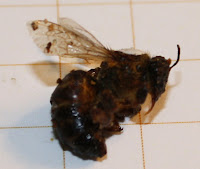I planted onion seeds for two varieties last autumn -- long red Florence and yellow of Parma. Rather than scattering seeds, I used my spacing template to plant 9 per square foot because the year before I tried to plant them close and found that it was too difficult to replant them later in the spring as sets. The Florence didn't come up as well this year as the Parma did. I attribute this primarily to voles or some other pest in the box where the Florence were planted.
But the bigger immediate question is how the seeds have fared so far when compared to sets. Because the Florence were spotty, I bought sets and planted them in the same raised bed. It allows me to make a direct comparison. The photo below compares the best Florence with 2 onions typical of those planted as sets. Not all the Florence are this big, but most are clearly larger than the onions planted from sets.

The Parma that were planted from seeds grew much more regularly and, overall, seem to be doing great. They are all tall and have developed nice thick stalks. It might be hard to make a direct comparison between the photos, but the Parma are uniformly as large as the Florence I captured above.

The conclusion is that I like seeds, at least so far. I have to figure out the pest problem and will move the bed where I plant next year if I can't kill the pests off.




























